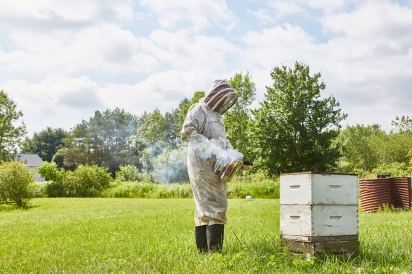A Beekeeper’s Curious Life: Rick Green of Ballston Lake Apiaries
After 40 years of beekeeping, Rick Green is still in awe of bees. He was 12 years old when he witnessed firsthand how bees survive in winter. A tree fell in front of his parents’ bar in Potsdam, New York, after a windstorm in the dead of a northern New York winter. A swarm of bees crawled out onto the fallen snow from a hive burrowed in the tree. Honey from honeycomb spilled out.
It was years later before Green encountered bees again. A computer software engineer, he moved to Rochester, New York, to work at Xerox. A beekeeper living in Powder Mills Park in a suburb of Rochester gave Green some equipment to hive a swarm. “He was the first beekeeper I’d met. This old beekeeper lived just down the street from me. It was at that time that I truly began to discover the magic of bees,” says Green.
What began with two hives has grown to 140. According to Green, 70,000 bees populate each of his hives: 10 million in all, producing five tons of honey a year. Green eventually bought equipment made by the Amish: stackable wooden frames, the current standard for beekeepers today. His frames mimic bee space in the hive: ⅜ of an inch each.
After hundreds of stings and 40 years of teaching others about bees and beekeeping—Green has written a book on the behavior of bees—he has a unique perspective on the life of bees. “Bees are social creatures and carry on very sophisticated lives. I believe they have behaviors that go beyond what most consider to be the capacity of an insect,” says Green.
Green lives in a house he built near Ballston Lake. He’s built three houses and six pole barns. His summer home in Little Falls, New York, is one of them. At his Ballston Lake home, he tends six Scottish Highland cows, had a flock of chickens that he recently sold and has an unending curiosity for life and just about anything that moves.
Twenty years ago, he went to night school to become a registered nurse. He became one of the first male nurses at the college he attended in the Hudson Valley. He went on to teach anatomy and physiology at a local community college.
Green says you can travel to Africa, spend lots of money to observe wild animals there, or you can walk into your backyard and observe what’s in the trees and on the ground. “It’s a matter of opening your eyes,” he says. He admits he sometimes throws cold water on people who want to keep bees but have never tried it. “I suggest they buy a suit and gloves and observe, or better yet, volunteer to work with an experienced beekeeper for a year, then decide. Beekeeping’s not for everyone.”
Green attributes his intuitive sense to growing up over his family’s bar. “I was tending bar at 14 years old. We were open 16 hours a day. When people come and go, you learn how to be intuitive. You get a sixth sense about what’s really going on.”
According to Green, after two successful and demanding careers, bees are his relaxation. “When I’m out by the hives, I look over my shoulder and no one’s there. Keeping bees is a natural way of being. It involves all of your senses. When there’s a problem with a hive, it doesn’t sound right; you can see symptoms of trouble, the scent isn’t what you’re used to. There’s a certain look to a hive when the queen is healthy.”
More has been written about honeybees than many other creatures. In 1972, Karl Ritter von Frisch won the Nobel Prize for his investigation into the communicative capacity of the honeybee. When in a dark hive, a honeybee gives a taste of nectar to other bees and alerts them as to where they can find it. “This is all expressed through a dance. Direction and distance are communicated to the hive according to angle of the sun,” notes Green.
“Honeycombs are built vertically. Dancing on a vertical surface, the bee dances a figure eight. The angle of the figure eight indicates the angle of the sun. When the bee strikes an angle, say 30 degrees, the bees fly out of the hive at a 30-degree angle to the sun to locate the nectar. How fast the bee wiggles during his dance indicates how far they have to go to reach the nectar.” Green adds that if the exit to a hive is blocked for 20 minutes, the bees will recalculate the angle of their journey. “One would surmise that they sense the passage of time,” he says.
His seminar entitled Beekeeping Through the Seasons introduces concepts such as the staying power of honeybees and how adaptive bees are as they collect nectar and pollen. Green shows microscopic slides of a honeybee’s anatomy to highlight how function and behavior are dictated by their tiny anatomical structures. In one slide of a honeybee’s elbow, he illustrates how a bee uses its two front legs as antennae cleaners to rub off pollen stuck to him.
“Bees are one of the few insects who can live through winter. They store pollen and honey to feed on during cold months. They take turns staying warm by moving to the center of the hive with the queen,” says Green.
On the quality and types of honey, he says, “Honey comes in varietals: different bees, different hives, different honey. There is a unique smell to nectars and pollens. Guard bees will only let in bees that match the hive to prevent other bees from stealing nectar.”
Green’s product line features four main products. Ballston Lake Apiaries sells a dark honey, August Buckwheat Honey, and a lighter honey, Clover Wildflower Honey. Unprocessed honeycomb is also available, sold to be eaten fresh from the comb. Honey cream, honey that’s crystalized, is popular as a spread for toast. Other products are a honey balsamic vinegar and spice marinade, and, for the last three years, mead, an early Greek and medieval alcoholic beverage made from fermented honey and apple juice that’s aged over two years.
As to the survival of bees, they’re now in danger, according to Green. “Though it’s important to keep things in perspective, we’re in an evolutionary valley right now in regard to honeybees. When you look at an expanse of time, there are dips. In 1800, every farmer had a beehive. Not so today. Bees are beset by diseases and pests such as mites.”
He says there are methods to fight things that befall the tiny honeybee. “There’s something of a black art to what we do. Everyone has a secret recipe for fighting mites and pests. These are hard-kept secrets, the mixing of essential oils, rarely shared among beekeepers.”
With stings, mites and risk, why keep bees at all? Green says, “Bees are a window. If you walk around your house or look at your car, that’s one way of observing, but if you observe something in depth, like bees, in great depth, you’ll look through a window to a very sophisticated and complex world.”








